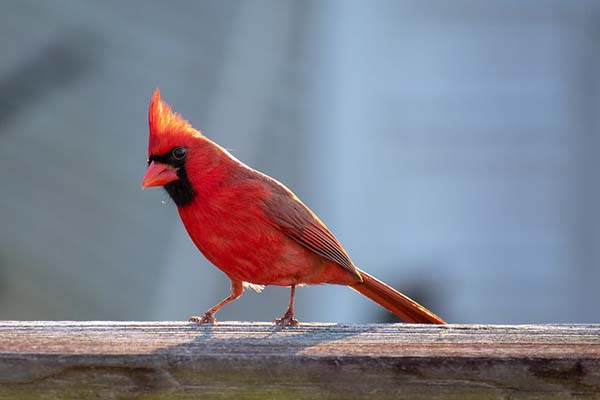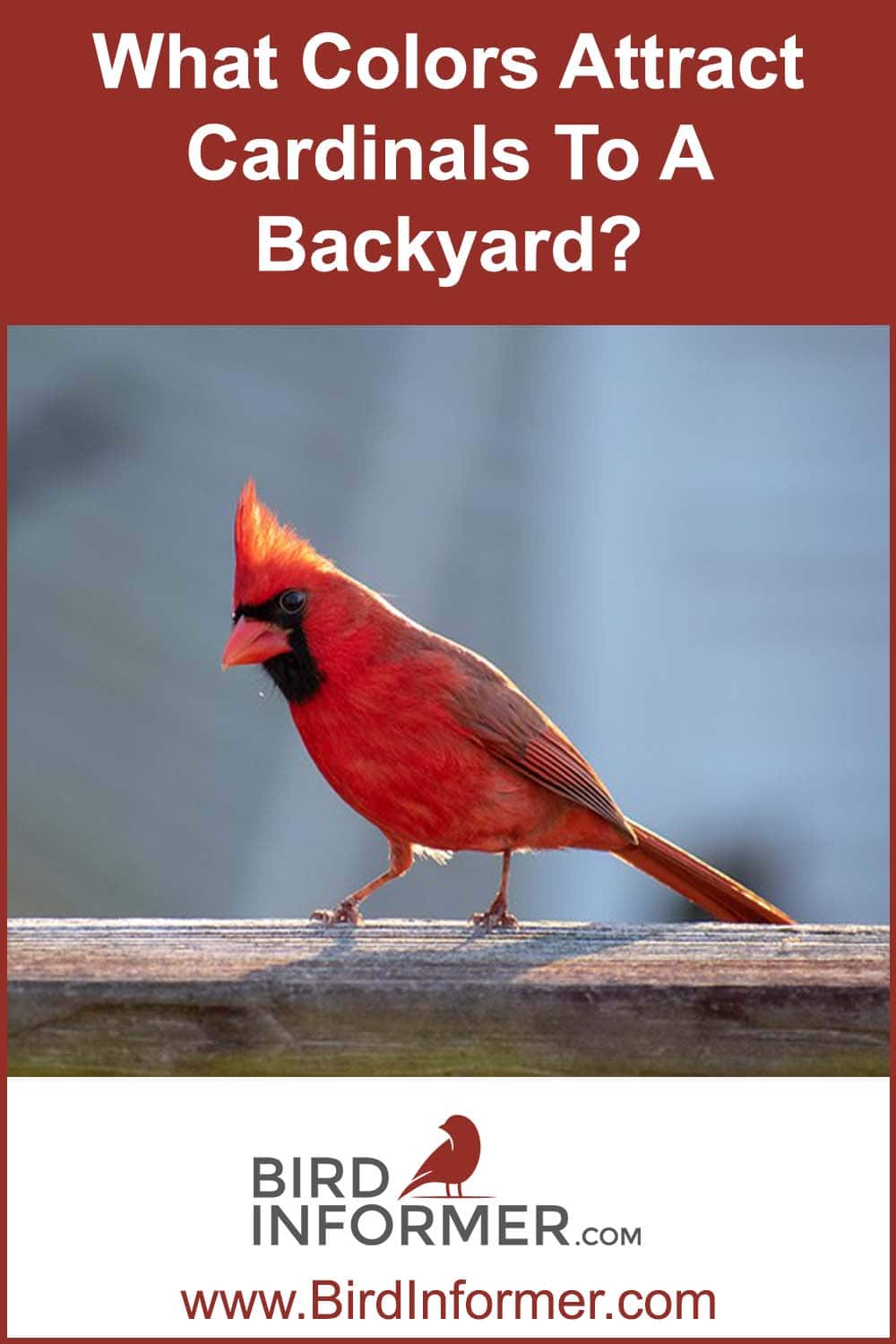Contents
Yes, birds behave differently with different colors. It might seem crazy, but it’s true. So which colors should you put out if you’d like to get a Northern cardinal to come to your backyard? What colors attract cardinals? Well, through my intense research, I’ve learned the secret of the color-coordinated cardinal.
Would you believe one color, and one color alone, can strike fear into the hearts of birds everywhere? Well, it’s true. That color?
White.
It truly does make all birds anxious and afraid. What about other colors? Well, you’ll just have to read on to find out what colors entice cardinals to come closer.

In this article, we’ll look at
WHAT colors attract cardinals…
WHY different colors affect certain bird species differently…
and,
HOW to use those colors to your advantage.
Read further to find out:
- Why different colors mean different things
- Which color is the cardinal’s favorite
- What other things can I do to attract cardinals
- What should I avoid doing
Different Colors Mean Different Things
When you think about it, color affects us in ways we can’t readily explain. Why does blue make people feel relaxed or even melancholy? Why does red make people feel agitated and even angry? Why do we feel a certain way wearing clothes of those different colors? It’s a scientifically proven fact that colors can affect moods in people. So, why is it so hard to believe it is true for other animals?
Well, it is.
While certainly setting out the right food mix and getting the right feeder for cardinals is important there is something else equally beneficial. It is thinking about the color scheme in the backyard. Which colors are more likely to attract cardinals than others?
Birds and Color Decoded
The world around birds gives them all kinds of signals. Sounds, sights, and smells all give off different signals to them. For instance, the smell of rotting birdseed will drive the cardinals away from the feeder. Loud sounds will keep them away too. But one of the most forgotten aspects of a backyard that can impact how birds behave is color.
You see, color is used to indicate all kinds of things to birds. They view color as an indicator for predation, migration, plant toxins, mating, and a food source.
While bright colors attract all birds, there are some species with very specific likes regarding colors. For instance;
- orange colors will draw Ruby-throated hummingbird and Baltimore oriole
- blue will entice Eastern bluebird and Blue jay
- green, brown, and gray will invite quail, thrushes, and doves
- red and pink will entice the cardinals and hummingbirds
Most bird species that are overly skittish will be drawn by earth tones.
Bird Color Code:
- Green, gray, brown – doves, thrushes, and quail
- Red and pink – hummingbirds and cardinals
- Blue – bluebirds and blue jays
- Orange – orioles, and hummingbirds
- Earth tones – skittish ground-feeding species
What Other Things Can I Do to Attract Cardinals?
There are a few things you can do aside from choosing reds and pinks around the yard to entice the cardinals to feed in the backyard.
Things to try:
- Place the right kind of feeder
- Offer the right kind of food
- Have Nesting Sites Available
- Place Nesting Platforms
The Right Kind of Feeder
Yes, different feeders can attract different kinds of birds. For cardinals, they like the open feeling of platform or hopper feeders. They are very watchful for predators and want to be able to see any potential predator approaching from any angle. Feeders with squirrel-busting technology are a plus too. If squirrels are kept away, then cardinals will feel safe as they feed without distractions.
The Right Kind of Food
The good news is cardinals are not picky eaters. They will eat almost any seed mix you want to set out for them. In nature, their diet consists of 70% of seeds, grass, and grains, and 30% insects. It’s one reason why they don’t migrate. Some birds rely on insects to make up 90% of their diet. For those birds, when winter rolls around, they move to where their food supply is, which is south. Cardinals, on the other hand, simply adjust their intake and feed on more seeds and grasses. They will welcome any kind of seed mix offering dried fruit, safflower seeds, and sunflower seeds.
Available Nesting Sites
It is very beneficial to have several different collections of shrubs, bushes, trees in which cardinals can nest. Because they build two nests every year and don’t reuse old nests it’s important to give them options. They build cup-shaped nests and prefer ample coverage so they aren’t easily seen. You can always plant some shrubs or bushes to give them options.
Offer Nesting Stands
Nesting stands are three-sided, open-topped structures that can draw cardinals to build nests. They should be placed within the branches of a shrub or bush to help the cardinals feel safe. They should be placed approximately 4 to 5 feet from the ground so they feel safe from ground predators such as house cats and foxes.
Also, even though cardinals do not reuse the same nests, once they are done with the mating season and their young have left, you can clean out the nesting platform to entice them to build again.
What Should I Avoid Doing?
Most bird lovers will do anything they can to attract their favorite birds to their yards. For most of them, it’s an endeavor of love. They buy the right food and feeder and want to sit back and enjoy watching their cardinal families come back again and again. So, why aren’t they coming?
Read on to find out why to avoid:
- Reflective surfaces
- Birdhouses
- Placing feeders close to the house
No Reflective Surfaces
Believe it or not, cardinals do not like reflective surfaces. For that reason, it is important to place bird feeders and nesting ledges away from windows. If cardinals see their reflection they will think it is another cardinal and begin attacking it, smacking into the window over and over again. This will only make them feel like they are always under attack and likely cause them to move to another location.
It is important to either cover up the reflexive surfaces or put screens over them so the reflective surface isn’t as obvious to the cardinals.
Place Feeders With Plenty of Space Around Them
Cardinals do not like feeling crowded. If you place a feeder too close to the house, cardinals will not come to perch and feed. They need to feel safe and secure. Make sure there is enough clearance on all sides so the cardinals can make sure the coast is clear on all sides.
Don’t Use Birdhouses
As forgiving as cardinals are concerning their diet, they are not forgiving in the same way about where they build their nests. If you have been shopping for a birdhouse and bought a nice fancy one for your cardinals you might as well take it back. Cardinals will not build a nest in it. BIrdhouses are typically too closed in for cardinals to feel safe.
They are a relatively large bird and aside from it being difficult for them to bring in their building materials to make a nest, they also like being able to see in all directions around their nest. So, don’t buy a birdhouse. Now, they do like nesting platforms which provide them with an open-topped place to build. Give those a try.
Conclusion
It’s important to note that while red and pink will likely entice cardinals to come into your backyard to feed and to potentially nest, color should be just one part of your overall plan to invite cardinal families to your yard.
Cardinals are the most widely recognized wild bird in North America. They typically will not stray further than one mile from where they were born. So, if you give them a nice setting and peaceful environment with proper food, water, and shelter, they will stay and flourish in your backyard for years of wonderful bird-watching pleasure.

